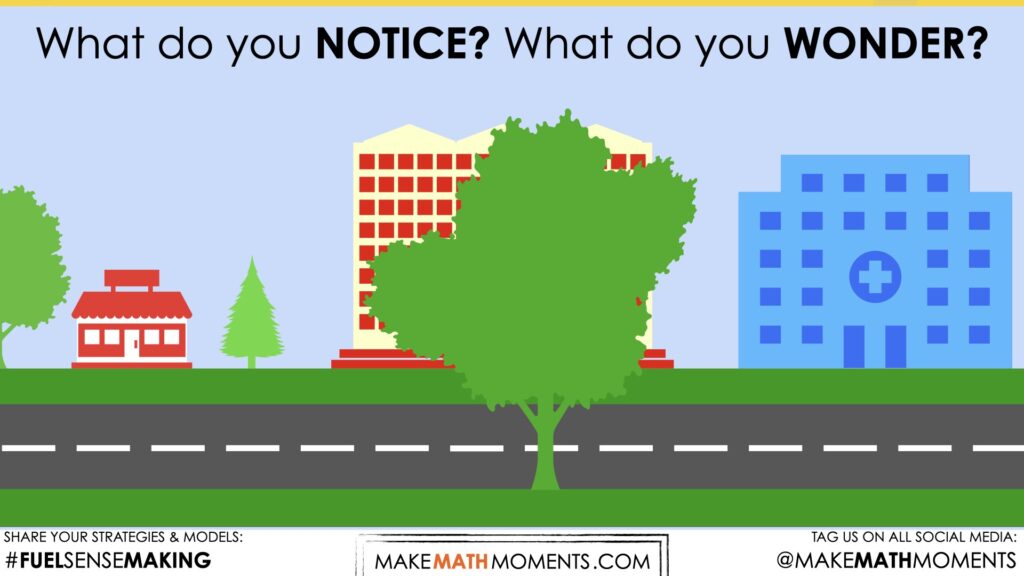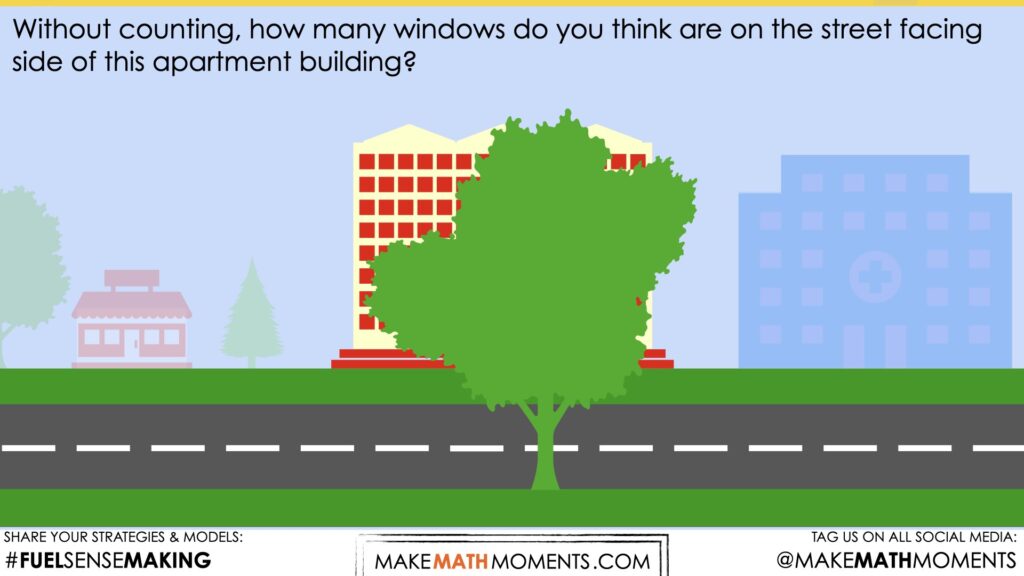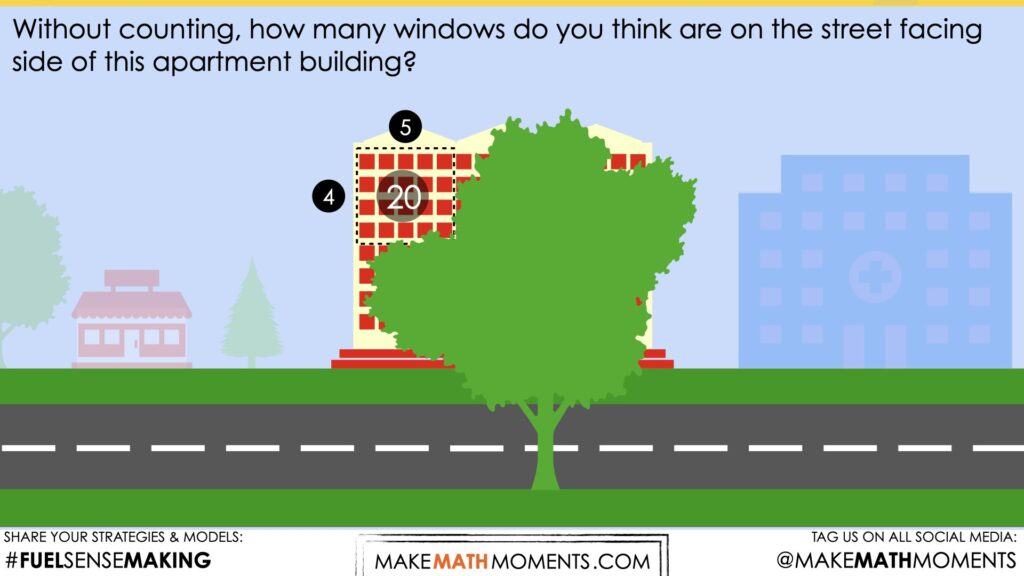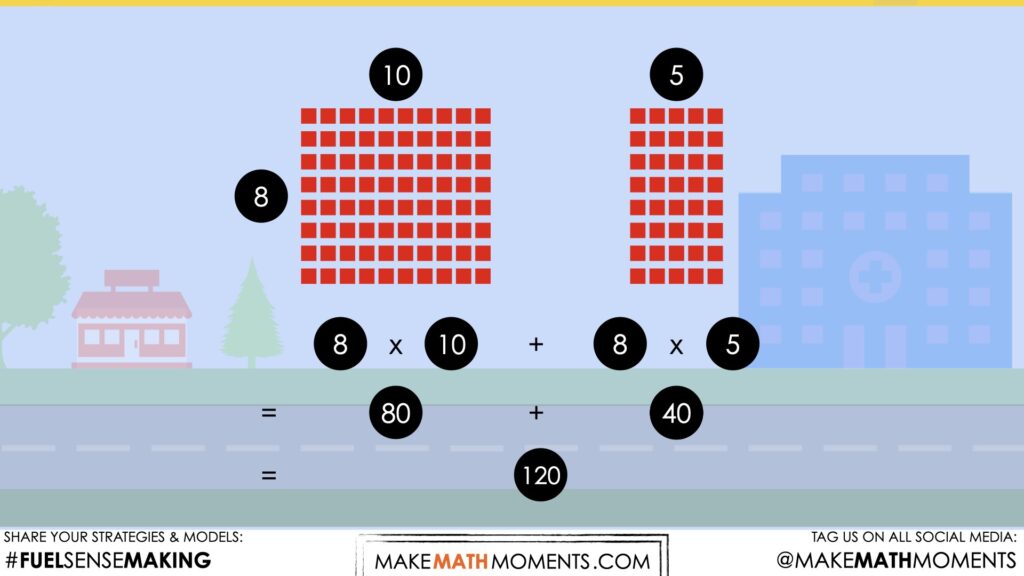STACK 'EM UP [DAY 3]
MULTIPLICATION: 1- & 2-DIGIT WHOLE NUMBERS
Introduction to 1- and 2-digit multiplication through context in order to emerge associative, commutative and distributive properties and models including the array and area model.
Intentionality
Spark Curiosity
Fuel Sensemaking
During Moves
Student Approaches
Next Moves
Consolidation
Reflect and Consolidation Prompts
Resources & Downloads
Educator Discussion Area
Intentionality & Unit Overview

Length of Unit: 5 Days
Access each lesson from this unit using the navigation links below
Students will determine which building has the greatest number of windows.
Intentionality…
In this problem based math lesson, students will determine which of three buildings has the greatest number of apartments based on the windows displayed on the front of the building. This comparison will allow students to leverage properties of multiplication through the array model in order to solve. Some of the big ideas that may emerge in this lesson include:
- Quantities can be compared spatially, through counting (additive), and through multiplicative comparison.
- Multiplication can involve determining the total quantity given the number of equal groups and the size of each group;
- The order of the numbers in a multiplication sentence does not matter (commutative property);
- The strategy of doubling and halving is possible due to the associative property of multiplication;
- The distributive property of multiplication supports the strategy of partial products (where one or both factors can be decomposed over addition or over subtraction).
Spark Curiosity
What Do You Notice? What Do You Wonder?
Show students the following video:
Then, ask students:
What do you notice?
What do you wonder?
Give students 60 seconds (or more) to do a rapid write on a piece of paper.
Replaying the video can be helpful here.
Then, ask students to share with their neighbours for another 60 seconds.
Finally, allow students to share with the entire group.
If you are new to the notice and wonder protocol, be sure to write down these noticings and wonderings on the blackboard/whiteboard, chart paper, or some other means to ensure students know that their voice is acknowledged and appreciated. If you use this routine often, you may not need to write down the responses if students are pretty responsive to the routine without much prompting.
Some of the noticing and wondering that may come up includes:
- I notice a street.
- I notice a building.
- I wonder what type of building it is.
- I notice there are a lot of windows.
- I wonder how many windows there are.
- There is a tree blocking a part of the building.
Estimation: Prompt
After we have heard students and demonstrated that we value their voice, we can land on the first question we will challenge them with:
Without counting, how many windows do you think are on the front of this apartment building?
Make an estimate.
We can now ask students to estimate how the windows there are.
Encourage students to craft a convincing argument as to where they arrived at their estimate. Is it a random guess? Did they determine how many windows they can see and spatially iterate that quantity overtop of the blocked sections of the building?
Estimate: Update
Ask a few students to share their estimates with the group. You might consider asking them to determine a number of windows that would be too low, and a number that would definitely be too high.
Share the following animation, and ask students to update their estimate.
Students will be able to see that there are 20 windows in the top left 4 by 5 window section of the building that is exposed.
Now that students have a referent of 20 windows, ask them to update and share their estimates.
Estimate: Reveal
Share the following video to confirm the total number of windows.
In the animation, we can see that the visual leverages the use of the distributive property of multiplication to create partial products by decomposing the factor of 15 into 10 + 5.
8 x 15 = 8(10 + 5)
The distributive property allows us to then create two more manageable products which can then be added afterwards for an easier mental computation.
Celebrate the estimates that were closest to 120 windows.
Fuel Sense-making
Crafting A Productive Struggle: Prompt
Login/Join to access the entire Teacher Guide, downloadable slide decks and printable handouts for this lesson and all problem based units.
During Moves
While Students Are Productively Struggling…
Login/Join to access the entire Teacher Guide, downloadable slide decks and printable handouts for this lesson and all problem based units.
Student Approaches
Student Approach #1: Skip Counting Using the Pictorial Arrays
Login/Join to access the entire Teacher Guide, downloadable slide decks and printable handouts for this lesson and all problem based units.
Student Approach #2: Partial Products
Login/Join to access the entire Teacher Guide, downloadable slide decks and printable handouts for this lesson and all problem based units.
Student Approach #3: Reasoning with Digital Manipulative
Login/Join to access the entire Teacher Guide, downloadable slide decks and printable handouts for this lesson and all problem based units.
Next Moves
Reveal
Login/Join to access the Purposeful Practice as well as the Teacher Guide, downloadable slide decks and printable handouts for this lesson and all problem based units.
Consolidation
Login/Join to access the Purposeful Practice as well as the Teacher Guide, downloadable slide decks and printable handouts for this lesson and all problem based units.
Reflect and Consolidation Prompts
Provide students an opportunity to reflect on their learning by offering this consolidation prompt to be completed independently.
Consolidation Prompt #1:
Login/Join to access the Purposeful Practice as well as the Teacher Guide, downloadable slide decks and printable handouts for this lesson and all problem based units.
Consolidation Prompt #2:
Login/Join to access the Purposeful Practice as well as the Teacher Guide, downloadable slide decks and printable handouts for this lesson and all problem based units.
We suggest collecting this reflection as an additional opportunity to engage in the formative assessment process to inform next steps for individual students as well as how the whole class will proceed.
Resources & Downloads
Login/Join to access the entire Teacher Guide, downloadable slide decks and printable handouts for this lesson and all problem based units.
Printable Lesson Plan PDF
Videos, Images & Media Files
Apple Keynote Presentation
Powerpoint Presentation
Printable Consolidation Prompts
Educator Discussion Area
Login/Join to access the entire Teacher Guide, downloadable slide decks and printable handouts for this lesson and all problem based units.
Explore Our 60+ Problem Based Units
This Make Math Moments Lesson was designed to spark curiosity for a multi-day unit of study with built in purposeful practice, number talks and extensions to elicit and emerge strategies and mathematical models.
Dig into our other units of study and view by concept continuum, grade or topic!







